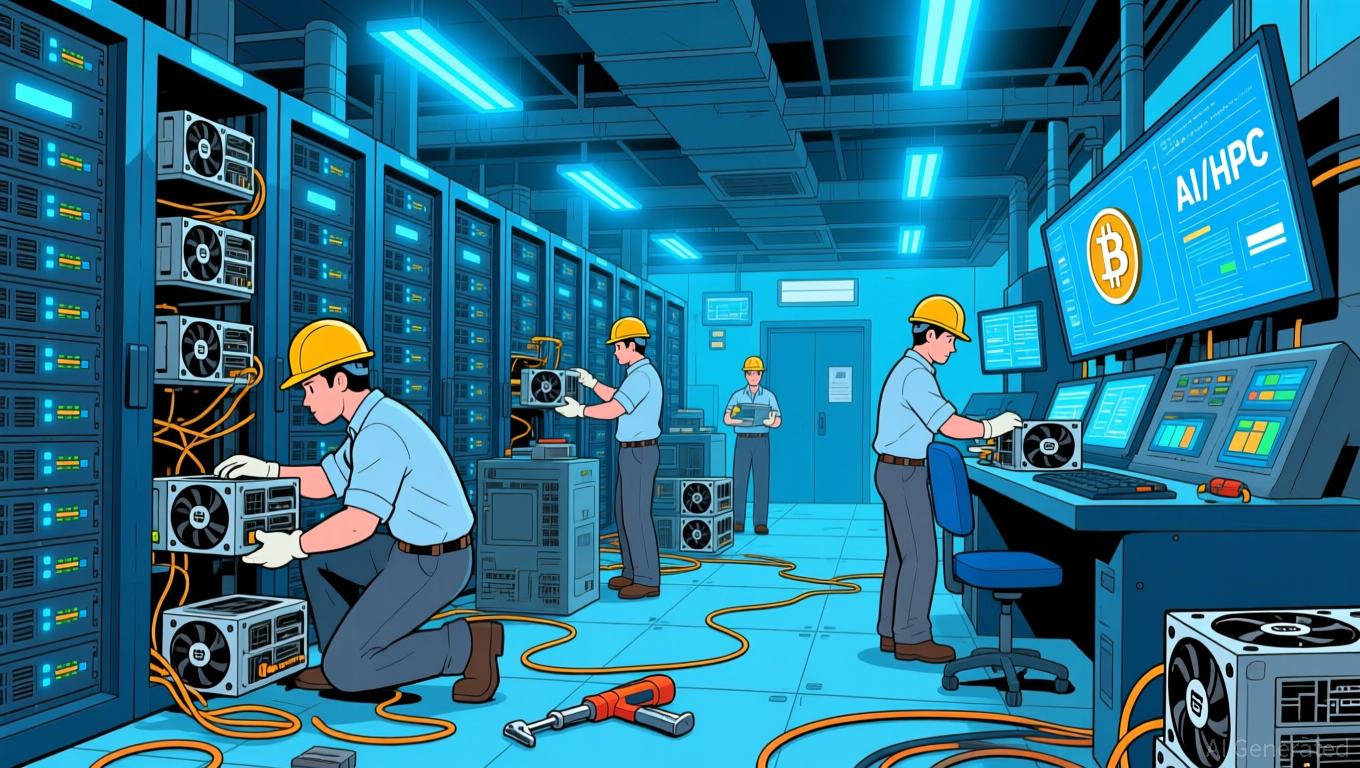Bitcoin News Update: As AI Sparks a Modern Gold Rush, Bitcoin Miners Shift Focus from Blocks to Bytes
- Bitcoin miners like CleanSpark pivot to AI/HPC as mining profitability declines, raising $1.15B for infrastructure expansion and share buybacks. - Industry peers TeraWulf and Core Scientific expand HPC capacity, shifting valuation focus to AI hosting revenue ($1.5-2M/MW/year) over hashrate growth. - Regulatory hurdles and GPU shortages challenge AI infrastructure scaling, but long-term demand projects U.S. data-center electricity use to hit 606 TWh by 2030. - Hybrid crypto-AI infrastructure becomes a sca
With profits from traditional Bitcoin mining shrinking, miners are rapidly branching out into artificial intelligence (AI) and high-performance computing (HPC).
This development follows Bitcoin mining difficulty reaching an all-time high of 155.97 trillion in late October 2025, marking a 6.31% increase from the previous adjustment. Meanwhile, hashprice revenue—the earnings per unit of computational power—fell to $41 per terahash per second (TH/s), approaching levels that threaten the survival of smaller miners,
CleanSpark’s $1.15 billion offering, increased from an initial $1 billion, carries 0.00% interest and a 27.5% conversion premium over its $15.03 share price at the time of announcement. Of the funds, $460 million will be used to buy back shares at $15.03 each, while the rest will go toward acquiring power and land, building data centers, and paying off bitcoin-backed credit lines,

This approach is similar to that of other companies like TeraWulf Inc. (WULF), which saw an 87% increase in revenue year-over-year in Q3 2024, fueled by both Bitcoin mining and AI/HPC services. TeraWulf’s Lake Mariner facility in New York now provides 22.5 MW of HPC capacity under long-term agreements with Fluidstack, supported by a $1.8 billion credit enhancement from Google,
The move toward AI is changing how mining companies are valued. Investors are now focusing more on contracted AI hosting revenue—ranging from $1.5 to $2.0 million per megawatt annually—rather than just hashrate growth,
Yet, obstacles remain. Regulatory issues, such as New York’s emissions reduction requirements for Greenidge Generation Holdings, underscore the importance of environmental compliance in AI infrastructure projects,
Experts point out that while Bitcoin’s price swings remain unpredictable, the transition to AI hosting provides miners with a cushion against the sector’s volatility. Marathon Digital Holdings (MARA), which acquired a 64% stake in EDF’s Exaion unit, and Iris Energy (IREN), which runs GPU clusters powered by renewables, are examples of the industry’s move toward more diverse revenue streams,
After CleanSpark announced its bond offering, its shares fell 4.9% in premarket trading, reflecting investor concerns about potential dilution from the convertible notes,
As Bitcoin miners contend with a bearish market, their shift toward AI marks a major transformation: facilities capable of supporting both ASIC and GPU workloads are becoming more valuable than raw hashrate alone. For CleanSpark and its competitors, securing access to power, land, and the electrical grid will be crucial for success as digital infrastructure becomes the backbone of both cryptocurrency and AI growth.
Disclaimer: The content of this article solely reflects the author's opinion and does not represent the platform in any capacity. This article is not intended to serve as a reference for making investment decisions.
You may also like
Cardano News Update: EMCD’s Crypto Card Connects Blockchain with Everyday Purchases
- EMCD launched a free crypto payment card enabling USDT spending via Mastercard , Apple Pay, and Google Pay, bridging digital assets to daily transactions. - Competitors like Exodus and Jour Cards introduced similar tools, targeting unbanked populations and expanding crypto utility for iTunes, gift cards, and global remittances. - Stablecoin transaction volumes hit $46 trillion in 2025, with 19% of crypto owners projected to use digital assets for payments by 2026, per eMarketer. - Traditional banks like

Lighter Secures $68 Million to Drive Institutional DeFi Expansion Despite Market Hesitancy
- Lighter secured $68M in a new round led by Founders Fund and Ribbit Capital, valuing it at $1.5B to boost DeFi trading infrastructure. - The funding aligns with a broader crypto VC surge, including Ripple's $500M and Lava's $200M, highlighting institutional interest in blockchain finance. - CEO Vladimir Novakovski emphasized scaling infrastructure with both equity and token subscriptions to enhance institutional-grade trading solutions. - Despite market caution, DeFi protocols like Lighter attract invest
JPMorgan and DBS Establish Unified Cross-Chain Protocol for Institutional Transactions
- JPMorgan and DBS develop blockchain framework for cross-chain tokenized deposit transfers, aiming to set institutional payment standards. - The framework links DBS Token Services with JPMorgan’s Kinexys, enabling 24/7 real-time settlements across public and permissioned blockchains. - It addresses cross-border transaction demands, reducing fragmentation as global banks adopt tokenization. - Overcoming interoperability challenges could redefine institutional liquidity access and market reach.

JPMorgan and DBS Develop Cross-Chain Bridge to Compete with Stablecoin Leaders
- JPMorgan and DBS Bank launch cross-chain framework for real-time tokenized deposit transfers between institutional clients, bypassing traditional payment systems. - The "interoperability highway" enables 24/7 settlements across public/private blockchains while maintaining consistent token value, expanding cross-border transaction capabilities. - As 1/3 of global banks explore tokenized deposits, the partnership challenges stablecoin dominance by offering institutional-grade cross-chain solutions with red